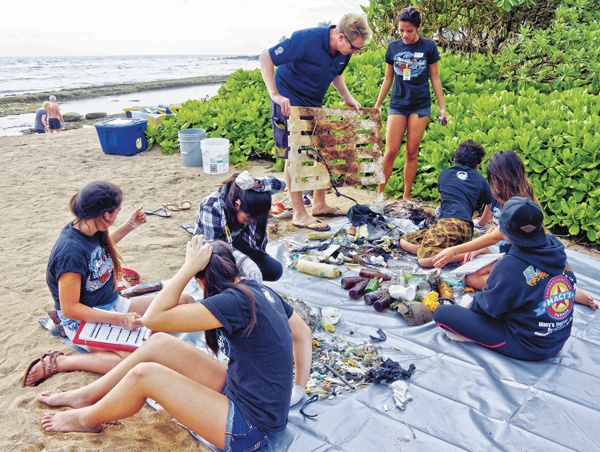NUKOLII — A beach cleanup was just the tip of the iceberg for nearly 300 Chiefess Kamakahelei Middle School eighth graders. Ending Friday afternoon, the students worked through a beach cleanup, but received plenty of lessons related to the marine
NUKOLII — A beach cleanup was just the tip of the iceberg for nearly 300 Chiefess Kamakahelei Middle School eighth graders.
Ending Friday afternoon, the students worked through a beach cleanup, but received plenty of lessons related to the marine debris they found.
“We started with little pieces,” said CKMS student Angelie Dacuycuy. “But then, we found more and more things.”
Joni Ortiz, the CKMS eighth grade science teacher, said the objective of the two-day outing was oceanography.
She said students worked with representatives from eight different community and government agencies to learn about marine debris and the effect it has on life.
Scott Bacon of Malama Na Apapa said he had a special prize for students who found debris in the cleanup with Japanese characters, or was distinctly Japanese, to see if it was a result of the tsunami.
“This wouldn’t be as good if we had this in school,” said CKMS student Kaya Estrada. “We wouldn’t be able to do all of these things. It just wouldn’t be the same.”
Students moved through the different stations, including gyotaku, marine debris, whales, water safety, circle barbless hooks, monk seals, and the Division of Land and Natural Resources Division of Aquatic Resources, which discussed the rates of decomposition of various marine debris.
Yumi Yasutake of the Papahanaumokuakea Marine National Monument discussed “Pono Fishing Practices” using real fish to help the students understand what was being said.
“I try to tell the students about the fish and its spawning cycles, how we need to respect the environment and not over-take so there will be more for another day,” Yasutake said.
In the gyotaku, or fish printing station, students learned not only an art form, but fish identification as well.
“In the days before digital cameras, this is how people got pictures of the fish they caught,” said CKMS student Kyra Hirokani, proudly showing off her fish print. “Today, they use sumie ink, but when people needed to show what they caught, it was done with rubbings.”
Ted and Marilyn Zetterberg of Portland, Ore., could not help but try and listen in, watching intently as students under the guidance of Mike Kano and Barry Werthwine of the Hawaiian Islands Humpback Marine Sanctuary lined along a length of rope laid out on the ground.
The line represented the length of a full-grown humpback whale, marked off in sections symbolizing the lengths of a newborn calf and a juvenile.
“We’re retired science teachers,” Marilyn said. “This is the best lab you could ask for.”
James Yamamoto, a roving photographer for the HIHWMS, could not help but return to the growing pile of debris at Malama Na Apapa led by Scott Bacon.
“The amount and type of rubbish is amazing,” Yamamoto, a retired high school teacher said. “The insult to the environment is astounding.”


